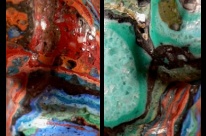

|

|
RAINBOW CALSILICA ::: 2006: This is an article that I wrote about Rainbow Calsilica about six or seven years ago when the material first arrived in Zuni. At that time it was being sold as an "all natural" material that was found in Mexico. All sorts of stories about how it was formed circulated. We avoided the material because our gut instinct told us it was man-made. Still, we were persuaded for a short time that it might be "real" when a trader in Zuni showed us photos of the "mine" and a letter stating the material was natural. Not long after lapidary journals started refuting these claims. I think it is generally accepted now that the material is man-made and likely does come from Mexico. We don't offer it often but sometimes a carving will catch our eye and, in that case, we'll offer it to you hoping it catches yours too. | |
|
There's been a lot of speculation and hype about the material called "Rainbow Calsilica" since it first became available about a year ago. We've heard a variety of stories from it being a composite material found in a Mexican arroyo created from dumped drilling mud wastes which combined with leeched minerals during the natural erosion process of the arroyo over a period of thirty or so years. This seemed suspect because we didn't feel the thirty year time period was sufficient to give anything the degree of hardness (even with stablization) necessary for carving, and we didn't think the colors of the 'stone' looked natural.
And we heard the stories about it being a Mexican product created by hand by artisans somewhere south of the border from 'melted tiles'. This too seemed unlikely as we couldn't understand how fired, glazed ceramic tiles could be melted, though we agreed that the colors certainly looked manmade.
Once the initial 'newness' of the material wore off and it seemed that most collectors had a piece of two of it in their collection, interest seems to have waned a bit. Certainly the astronomical prices it brought initially came back to a more realistic place on earth.
It has never been one of my favorite carving materials partly because of its vague origins, and partly because the colors just did not appear natural to me. So on this most recent buying trip when one of the traders approached me with some newly arrived fetishes carved from it ... I explained my feelings about the stone. He then shared the following letter with me and showed me color pictures of the mine. (He also told me the country of origin of the mine, but I have forgotten it.) This material IS NATURAL! And appears in seams of color in the host rock (volcanic rhyolite) of this mine. The first specimens mined contained lots of reds and yellows, along with greens and blues ... and the more recent specimens collected have more green and blue than pastel colors. It is heavily stablized ... but somehow I feel better knowing it does appear in nature. I am sharing the content of the analysis done on the material below.
In order to protect the privacy of the mine owner and the agency doing the analysis,
So, there you have it ... another version of the "Story of Calsilica". I don't think it will ever replace picasso marble or Zuni rock when it comes to fetishes being carved... but it appears that it is an interesting quirk of Mother Nature and not toxic waste or melted crayons like we might have imagined!
And then there's THIS:
"Rainbow calsilica was a show-stopper at this year's shows, no doubt about it. With its bright striped layers of red-orange, blue, green, and yellow, it stands out in almost any crowd of gemstones. It's hard to believe that a material like this could be produced in nature — and, sadly, it isn't.
Rainbow calsilica has been sold as microcrystalline calcite in allophane from a mine in Chihuahua, Mexico. While the base material does indeed contain calcite, when scientists from the Swiss Gemmological Institute (SSEF) and Ghent University in Belgium examined a sample they found artists' pigments in the blue, yellow, and green layers, hematite in the red layers, and celestine in the black. "Our samples appear to have been made of pulverized carbonate rock that was mixed with pigments and stabilized with a polymer," concluded their report, which was published in the Winter 2002 issue of Gems & Gemology."
|
||
|
Contact us! |
Index |
About ZS
//////////////////////////
ZUNI SPIRITS////
P. O. Box 337, Grapeland, TX 75844.......
936 687 2994 ....... © 2000 - 2006 | ||